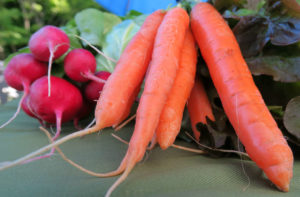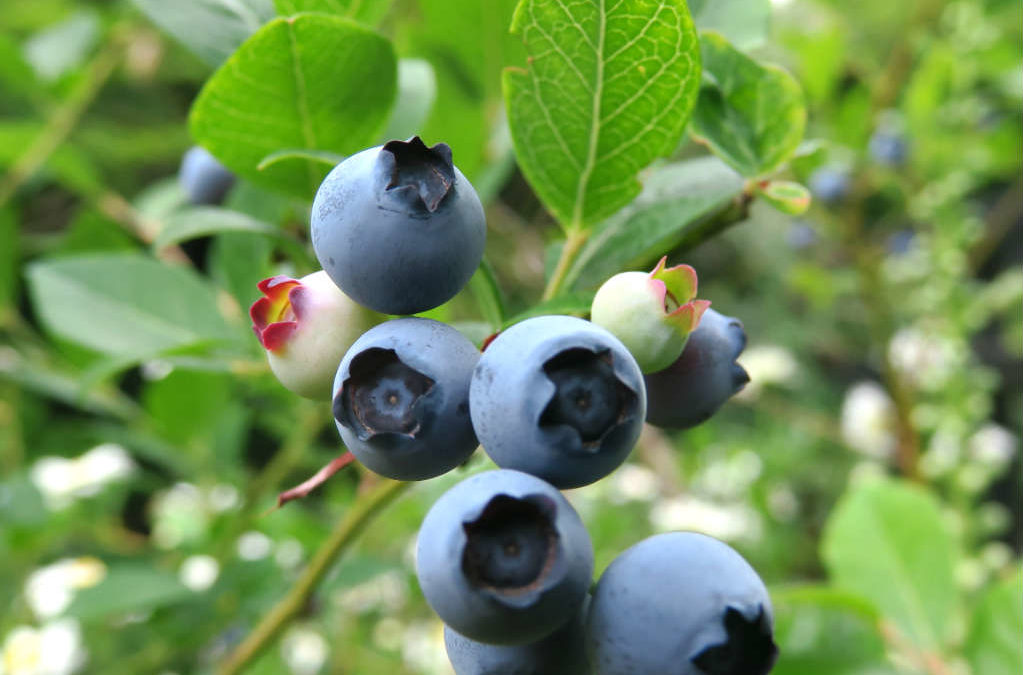I am a “fruit-aholic”. I love fruit. Even as a kid, I craved fruit– especially the summer fruits–strawberries, blueberries, peaches, plums. The juiciness, the flavors, the short summer season so taste boredom never arrived–all reasons summer fruits satisfied immensely. As an adult, I still love fruit, but now I find sweetness in vegetables–carrots, Brussels sprouts, and cabbage. It’s the natural sweetness that I long for.
Looks can be deceiving though. I’ve been snookered into buying a pint of the biggest, plumpest blueberries with a deep blue sheen–and they taste like wood or what I at least imagine wood tastes like. So, what is it that makes a piece of produce just taste so good?
Is it Just Memories that Taste Good?

Luscious Bluberries
I looked back at my childhood, to gather data from my memories. As a kid, Grandpa Peters–the quiet, introverted engineer–drove me to a neighbor’s strawberry fields to pick a flat. Sweat dripping from my face in the sweltering sun, I bent over a row of plants lifting the leaves to find a treasure of red berries. Instinctively, I wanted to pick the biggest berries, but knew that the smaller ones also packed a punch of sweetness. Picking berries with a tinge of green was however, totally unacceptable, as they were bitter. To reward myself for my effort, it was one in the mouth, one in the basket, one in the mouth, one… It’s lucky the neighbor didn’t weigh me before I started picking and I wasn’t making a living picking berries.
Fresh red strawberries, no more than a few seconds old are divine. But, even after bringing them back to Grandpa and Grandma’s house, they were still marvelous, perhaps with just a little whipped cream. Did picking my own berries make them test better?
Grandma Peters–the joyful, loving, teaching, and extroverted grandma–and I picked wild black caps (black raspberries) on the edge of untended forest at the top of the ‘back 40’ slope in the heat of the summer. Following the jam recipe on the back of the liquid CERTO pack, we crushed the berries, mixed in the liquid pectin, and added the prescribed amount of sugar. The statement, “DO NOT REDUCE THE SUGAR IN THE RECIPE SINCE THAT WILL RESULT IN SET FAILURES,” scared me into obeying every word in the directions. Boiling the fragrant black mass as the recipe demanded for “exactly 1 minute, stirring constantly” was critical before ladling the preserves into jars ensuring success. The final step, to prepare the jam for extended storage, meant pouring 3/8″ of freshly melted preserving wax on top of the jelled preserves. Two-piece vacuum caps and lids, now standard for protecting and preserving jam, didn’t exist 50 years ago.
Opening a jar of black cap jam in the middle of the winter and spreading it on toast, brought the waft and taste of summer to my senses. Did using the freshest berries make it taste better?
Oma and Opa Gardow jointly owned “the Farm” with other German immigrant families about an hour’s drive outside of Buffalo, New York. Down the steep hillside, from the horse stables that had been converted into tiny weekend getaway cottages, were wild giant high bush blueberry plants. Being a kid, I could only pick from the lowest branches and looked up at what seemed like bushes as tall as the cottages. Dressed with long sleeves, pants, and boots, mosquitoes and flies buzzed around my head, as my feet sunk into the mud. I hated the bugs, as I was and still am a mosquito attractor. Again, the berries were luscious, sweet, and juicy. Oma was an excellent cook and preparer of meals and used the berries to make a pie. Was picking the berries with my own hands the secret for flavor?
With all that I learned from my grandparents, to this day, I still make jam, (chutneys, relishes, salsas, and pickled vegetables) and follow every direction as it is exactly written. Using only the freshest ingredients from the farmers’ market, my CSA box, or my garden, I savor the sweetest tastes of summer opening every jar I canned during the darkest days of winter. What is it that makes my canned food taste so good?
The Secret Ingredient
My own labor growing, picking, or selecting the freshest ingredients are definitely factors that make my food taste better. But, is there something else? Reading Dan Barber, chef extraordinaire and author of The Third Plate, I learned the secret ingredient. “When we taste something truly delicious, something that is persistent, it most likely originated from well-mineralized, biologically rich soils.”

Summer Radishes and Carrots
At the base of the wild black cap brambles at the forest edge, the ground was strewn with old leaves and layers of humus. The blueberry bushes sucked the water and minerals from the soggy soils to produce the most succulent berries. Fifty years ago, strawberry fields were family run and managed the old-fashioned way for the best flavor rather than optimized for travel, color, and profit. The most extraordinary tasting food comes from the best soils. It’s the dirt that matters. As Dan Barber says, “the more minerals available for the plant to synthesize, the more opportunity for better flavor.”
Try it yourself. Buy a box of berries or bunch of carrots from a mainstream grocery store and the same from a local, organic farmer. Do a blind taste test. Savor the flavor. Which tastes best?
Kathryn Gardow, P.E., is a local food advocate, land use expert and owner of Gardow Consulting, LLC, an organization dedicated to providing multidisciplinary solutions to building sustainable communities. She is also the Chief Operating Officer of MetroAG Strategies founded to integrate growing food into places where people live. Kathryn has expertise in project management, planning, fundraising, and civil engineering, with an emphasis on creating communities that include food production. Kathryn is a Washington Sustainable Food and Farming Network board member and on the Urban Land Institute–Northwest District Council’s Center for Sustainable Leadership planning team. Kathryn’s blog muses on ways to create a more sustainable world and good food!

